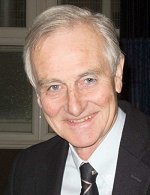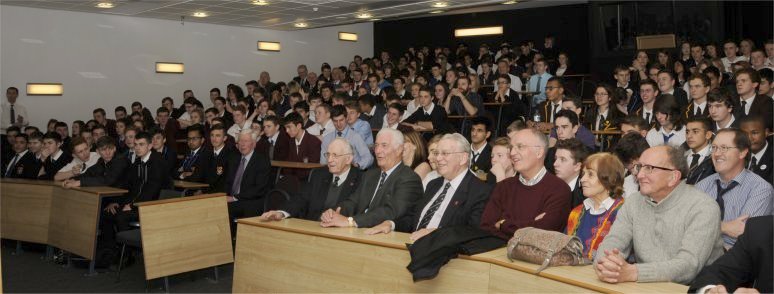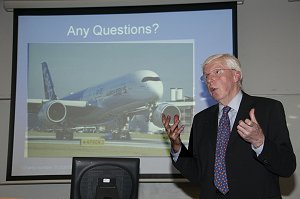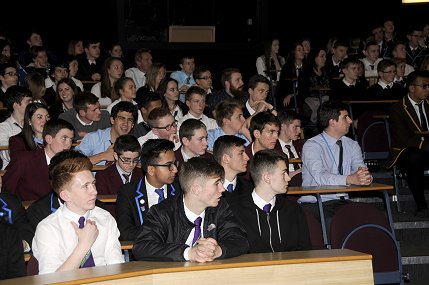Allan Glen Tribute Lecture
Until curtailed by the pandemic, The Allan Glen Tribute Lecture was run with the aim of encouraging interest in engineering among school pupils, and publicising the scholarships which the Endowment Trust awards. The first Allan Glen Tribute Lecture took place on Monday the 26th November 2007 in the Royal College of Physicians and Surgeons of Glasgow. That lecture was given by Professor Emeritus Herb Saravanamuttoo of Carleton University in Ottawa, Canada' who was also a former pupil of Allan Glen’s School. His lecture explored the tremendous advances which were made in commercial flight and which were largely due to Sir Frank Whittle and his invention of the jet engine.
This first lecture was an outstanding success and the next six lectures were also hosted in that venue. However, the popularity of the lecture soon meant that demand for places could not be met and some applicants had to be turned away. In 2014 the Strathclyde University Engineering Department offered the use of a lecture theatre in the McCance Building (named after Andrew McCance, another former pupil of Allan Glens) which could accommodate 250 people and this remasined the home of the annual lecture until it ceased.
Some lectures:-
Pumping Iron: The Science and Engineering of the Heart

The lecture entitled Pumping Iron: The Science and Engineering of the Heart covered a subject close to the heart of the Club’s own Consultant Cardiologist, Professor Henry Dargie FRCP, FFSC, FRSE.
Henry started by explaining how he was unwittingly persuaded to study Latin when he first started at Allan Glen’s. He suspected that his parents might have wanted him to become a doctor although he himself had no ambition at that stage to study medicine. As the lecture progressed, though, it became obvious that Henry had opted to focus on the operation of the heart and demonstrate its workings in engineering terms.
Knowledge of those workings is now better understood through the technology of advanced equipment that engineers have designed and manufactured for medical diagnostics. The ability to unobtrusively observe a heart in operation provides vastly more information than the examination of a defunct heart and also offers the opportunity to save the life of the patient.
Results of new treatments can be visually observed as well as being monitored and adjusted if necessary. Sample videos taken from such equipment were displayed showing comparisons between healthy and unhealthy hearts. The introduction of catheters, stents and replacement valves in the treatment of heart disease was explained as was the fitting of pacemakers. It was clear that none of these treatments would be possible without the skill of engineers to design and manufacture these devices.
During his lecture he stressed that the heart is the only organ that works non-stop in the body from birth until the day you die. He explained that in every 24 hour period the heart pumps 8 tons of blood. The use of MRI scanners, pacemakers, defibrillators was included together with explanations of the electrical circuits which regulate the heart.
Heart transplant was a subject where new innovations are taking place to keep the heart beating during transportation from the donor to the recipient. This, the audience were told would keep the heart in better condition through the journey rather than the cryogenic procedures used since the 1960’s. The British Heart Foundation video made with Vinnie Jones was shown to highlight the fact that many heart attack patients die because the people present at the time do nothing other than stand and look. Henry explained that immediate action using the procedure in the video can actually save lives, and mention was made of the decreasing cost of defibrillators and their increasing availability in sports clubs. In his closing remarks Henry stressed to the audience the harmful effects of smoking and bad diet to the health of the heart. At the conclusion of his presentation pupils were invited to ask questions and with some prompting from Professor Nash the question and answer session got under way.
Flight Test and Engineering
This lecture was held on Main Lecture Theatre in the McCance Building in the University of Strathclyde and waas given by John Bolton, former chief test pilot for BAE and deputy chief test pilot for Airbus. There was a capacity audience of 250 students from 22 Glasgow schools.

John started his lecture by explaining how he first became interested in flying when he joined the Allan Glen’s Air Training Corps and that while studying engineering at university he had joined the University Air Squadron. He caused some amusement when he explained that he was quite a small boy at school and that on his first flight in a Chipmunk with the ATC he had to sit on three cushions so that he could see out of the window.
 After gaining his degree in the 60s when mathematical calculations were still being carried out by hand with slide rules (long before the advent of computers) he decided against an office bound job where he would have worked on stress calculations on wing structures. Instead he opted to join the Royal Air Force. He then took the audience through a sequence of slides showing the vast array of different aircraft that he had flown. This led onto the point where he left the RAF and returned to civilian life.
After gaining his degree in the 60s when mathematical calculations were still being carried out by hand with slide rules (long before the advent of computers) he decided against an office bound job where he would have worked on stress calculations on wing structures. Instead he opted to join the Royal Air Force. He then took the audience through a sequence of slides showing the vast array of different aircraft that he had flown. This led onto the point where he left the RAF and returned to civilian life.
 He explained that he then joined BAE where he became chief test pilot and subsequently Airbus where he was deputy chief test pilot. His presentation included slides which displayed aircraft wings flexing to form parabolic curves from the body of the aircraft which would be more associated with birds rather than an aircraft.
He explained that he then joined BAE where he became chief test pilot and subsequently Airbus where he was deputy chief test pilot. His presentation included slides which displayed aircraft wings flexing to form parabolic curves from the body of the aircraft which would be more associated with birds rather than an aircraft.
In fact the audience was spellbound when told that the wing recovered its horizontal level position after that stress without suffering any physical damage. Other slides included embedded videos of aircraft being tested under a wide variety of conditions and it was particularly interesting to see the new Airbus 350 which will be going into service next year, being put through its paces. At the conclusion of his presentation there were numerous questions from the pupils.